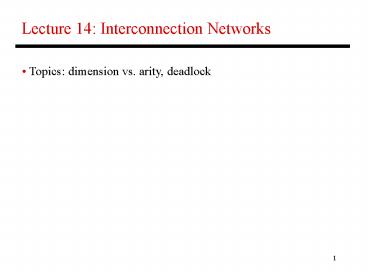Lecture 14: Interconnection Networks - PowerPoint PPT Presentation
Title:
Lecture 14: Interconnection Networks
Description:
Lecture 14: Interconnection Networks Topics: dimension vs. arity, deadlock University of Utah Interconnection Networks Recall: fully connected network, arrays/rings ... – PowerPoint PPT presentation
Number of Views:46
Avg rating:3.0/5.0
Title: Lecture 14: Interconnection Networks
1
Lecture 14 Interconnection Networks
- Topics dimension vs. arity, deadlock
2
Interconnection Networks
- Recall fully connected network, arrays/rings,
meshes/tori, - trees, butterflies, hypercubes
- Consider a k-ary d-cube a d-dimension array
with k - elements in each dimension, there are links
between - elements that differ in one dimension by 1 (mod
k) - Number of nodes N kd
Number of switches Switch degree
Number of links Pins per node
N
Avg. routing distance Diameter
Bisection bandwidth
d(k-1)/2
2d
d(k-1)
Nd
2wkd-1
2wd
Should we minimize or maximize dimension?
3
Butterfly Network
P0
000
000
P1
001
001
P2
010
010
P3
011
011
P4
100
100
P5
101
101
P6
110
110
P7
111
111
4
Bisection Bandwidth
- Break the kd nodes into two groups such that all
elements - in group-1 are of the form 0 - k/2-1
... - in group-2 are of the form k/2 k
... - Each node has an edge to other nodes that differ
in only one - dimension by one
- Any node in group-1 differs from any node in
group-2 in at - least the first dimension hence, any edge
from group-1 to - group-2 is an edge that connects nodes that are
identical in - d-1 dimensions and differ in the first
dimension by 1 - If we fix the co-ordinates of the d-1
dimensions, we can - identify two edges 0, i1,,id-1 k-1,
i1,,id-1 and - k/2-1, i1,,id-1 k/2, i1,,id-1 there
are totally 2kd-1 edges
5
Dimension
- For a fixed machine size N, low-dimension
networks have - significantly higher latencies for a packet
scalable - machines should employ high dimensionality
(high cost!) - For a fixed number of pins, message latency
decreases at - first, then increases (as we increase
dimensionality) - What if we keep constant bisection bandwidth?
- Lower dimensions also reduce wire length
Number of switches Switch degree
Number of links Pins per node
N
Avg. routing distance Diameter
Bisection bandwidth N kd
d(k-1)/2
2d
d(k-1)
Nd
2wkd-1
2wd
6
Routing
- Deterministic routing given the source and
destination, - there exists a unique route
- Adaptive routing a switch may alter the route
in order to - deal with unexpected events (faults,
congestion) more - complexity in the router vs. potentially better
performance - Example of deterministic routing dimension
order routing - send packet along first dimension until
destination co-ord - (in that dimension) is reached, then next
dimension, etc. - Routing strategies source-based,
arithmetic-(destination) - based, table-driven
7
Deadlock
- Deadlock happens when there is a cycle of
resource - dependencies a process holds on to a resource
(A) and - attempts to acquire another resource (B) A is
not - relinquished until B is acquired
8
Deadlock Example
4-way switch
Input ports
Output ports
Packets of message 1 Packets of message
2 Packets of message 3 Packets of message 4
Each message is attempting to make a left turn
it must acquire an output port, while still
holding on to a series of input and output ports
9
Deadlock-Free Proofs
- Number edges and show that all routes will
traverse edges in increasing (or - decreasing) order therefore, it will be
impossible to have cyclic dependencies - Example k-ary 2-d array with dimension routing
first route along x-dimension, - then along y
1
2
3
2
1
0
18
17
1
2
3
2
1
0
17
18
1
2
3
2
1
0
16
19
1
2
3
2
1
0
10
Breaking Deadlock I
- The earlier proof does not apply to tori because
of - wraparound edges
- Partition resources across multiple virtual
channels - If a wraparound edge must be used in a torus,
travel on - virtual channel 1, else travel on virtual
channel 0
11
Breaking Deadlock II
- Consider the eight possible turns in a 2-d array
(note that - turns lead to cycles)
- By preventing just two turns, cycles can be
eliminated - Dimension-order routing disallows four turns
- Helps avoid deadlock even in adaptive routing
West-First
North-Last
Negative-First
Can allow deadlocks
12
Title
- Bullet































